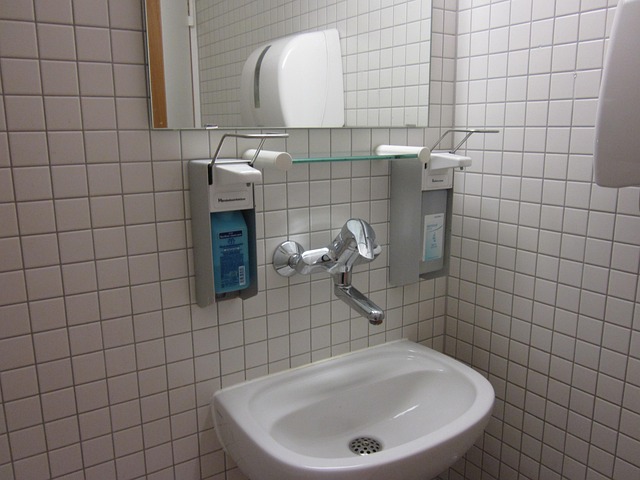Designing functional bathrooms for rentals requires understanding tenant usage patterns and selecting durable, low-maintenance materials like ceramic tiles, moisture-resistant flooring, and scratch-resistant countertops. Incorporating strategic features such as built-in storage, smart technology, efficient water usage fixtures, and strategic mirror placement enhances aesthetics and practicality while reducing maintenance needs. The use of stainless steel, vitrified ceramic tiles, and stain-repellent coatings ensures longevity, and case studies demonstrate successful renovations that balance visual appeal with tenant needs.
In the dynamic world of rental properties, creating functional bathroom designs that endure tenant use is paramount. This article explores how to achieve this through understanding tenant behavior, selecting robust and low-maintenance materials, and incorporating thoughtful features. We delve into strategies to avoid common maintenance pitfalls, drawing from successful case studies. Discover how these approaches transform rental bathrooms into durable, hassle-free spaces that enhance tenant satisfaction and property values.
Understanding Tenant Usage Patterns for Durable Design
Understanding tenant usage patterns is a key aspect of designing durable and low-maintenance spaces, particularly in the context of functional bathroom design for rentals. Tenants, compared to homeowners, may not invest as heavily in maintenance or upkeep, so the design needs to account for more frequent use and potentially rougher handling. This involves considering how often the space will be used—for example, high-traffic bathrooms in shared spaces require sturdier fixtures and finishes that can withstand multiple users throughout the day.
Additionally, tenant behavior plays a significant role. Understanding common activities like quick showers or less careful cleaning can help inform material choices. Durable materials like ceramic tiles, for instance, are easier to maintain and more resistant to scratches and stains compared to softer surfaces. Low-maintenance features such as moisture-resistant flooring and scratch-resistant countertops further ensure the bathroom remains functional and aesthetically pleasing over time, even with frequent use.
Selecting Low-Maintenance Materials for Longevity
When designing a functional bathroom for rental properties, selecting low-maintenance materials is key to ensuring longevity and minimizing tenant turnover. Opting for durable surfaces like porcelain or ceramic tiles over delicate finishes can prevent common issues like chips, scratches, and stains. These materials are easy to clean and resist mold growth, making them ideal for high-moisture environments.
Furthermore, incorporating non-porous surfaces such as solid surface countertops or quartz ensures that the bathroom remains stain-free and sanitary. These materials don’t absorb moisture, reducing the risk of water damage and the need for frequent repairs. By prioritizing low-maintenance options in rental bathroom design, property managers can create spaces that are not only aesthetically pleasing but also practical and long-lasting.
Incorporating Functional Features in Bathroom Layouts
Incorporating well-designed, functional features into bathroom layouts is a key aspect of creating durable and low-maintenance spaces that cater to tenants’ needs. A thoughtful approach to bathroom design can significantly enhance the overall user experience while ensuring longevity in rental properties. For example, installing quality, easy-to-clean surfaces like porcelain or ceramic tiles not only adds aesthetic appeal but also stands up to daily use. Additionally, incorporating features such as built-in storage solutions and smart technology—like moisture-resistant, touchless faucets and automated lighting—not only keeps the space organized and efficient but also contributes to a modern, appealing atmosphere.
Functional bathroom design for rentals should prioritize practicality without sacrificing style. Strategically placed mirrors, for instance, can create the illusion of more space while providing essential functionality. Similarly, efficient water usage fixtures and well-organized storage can reduce clutter and make the most of limited floor space. These thoughtful details not only make the bathroom more comfortable but also contribute to its overall durability and maintainability, ensuring a positive tenant experience throughout their stay.
Avoiding Common Maintenance Pitfalls with Rental Bathrooms
When designing a functional bathroom for rentals, avoiding common maintenance pitfalls is key to ensuring longevity and minimizing vacancy periods. Many standard bathroom materials may be aesthetically pleasing but are not built to withstand frequent use by tenants. For example, traditional porcelain fixtures can chip or crack under harsh cleaning products or heavy objects. Opting for durable alternatives like stainless steel and vitrified ceramic tiles offers greater resistance to damage and makes cleanup easier. Low-maintenance finishes also mean less time spent on repairs and more money in the landlord’s pocket.
Furthermore, incorporating easy-to-clean surfaces and water-efficient fixtures can significantly reduce maintenance needs. Water spots and stains on mirrors and counters are unsightly and can indicate larger issues. Choosing scratch-resistant glass and stain-repellent coatings helps keep these areas looking their best with minimal care. Efficient showerheads and faucets not only save water but also minimize the buildup of limescale, another common maintenance headache in rental bathrooms.
Case Studies: Successful Implementation of Durable, Low-Maintenance Bathrooms
In the realm of functional bathroom design for rentals, several case studies exemplify the successful implementation of durable and low-maintenance materials. These projects demonstrate that aesthetics and practicality can coexist harmoniously in rental properties. For instance, a recent renovation project in a high-density urban area prioritized scratch-resistant ceramic tiles alongside water-efficient fixtures to create bathrooms that not only look modern but also withstand the rigors of tenant use. The use of these materials has significantly reduced maintenance costs for the property manager while ensuring a consistent and appealing environment for residents.
Another notable example involves the adoption of easy-to-clean, non-porous surfaces such as quartz countertops and stainless steel appliances. These choices have not only elevated the bathroom’s visual appeal but also made cleaning and maintenance tasks considerably more straightforward for both tenants and property managers. Such implementations underscore the importance of balancing design, durability, and low maintenance in creating functional bathrooms that cater to a diverse tenant pool while minimizing long-term costs.
In conclusion, designing durable and low-maintenance bathrooms for rentals is a strategic approach that combines understanding tenant usage, selecting robust materials, and incorporating thoughtful features. By adopting these practices, landlords can ensure long-lasting spaces that require minimal upkeep, enhancing tenant satisfaction and property value. This functional bathroom design for rentals not only saves time and money but also fosters a positive living environment, making it a winning strategy in the rental market.
